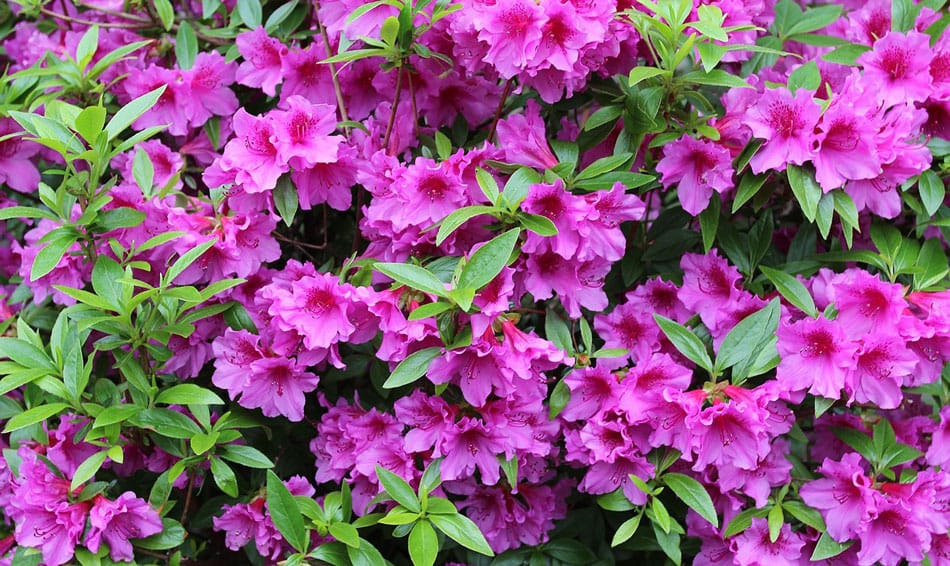In the spring here in central New Jersey and eastern PA, one of the things you might want to consider doing is rejuvenation pruning. Rejuvenation pruning, also called renewal pruning, involves cutting some types of shrubs almost down to the ground, leaving only 6 to 24 inches.
Done every three to five years, this extreme method of pruning can indeed rejuvenate an overgrown or misshapen shrub, just as the name implies. But, to be successful, it should be done at the right time, in the right way, and to the right shrubs.
When is rejuvenation pruning needed?
This radical form of pruning is used when shrubs are overgrown, unsightly, dying in the interior and/or have stopped (or greatly reduced) producing flowers. This typically happens to fast-growing, multi-stemmed shrubs if they haven’t been properly pruned for several years.
Rejuvenation pruning gives these shrubs a fresh start. After stems have been removed down to the ground, the shrub quickly begins to regrow. Flowering shrubs produce more blossoms in following years and shrubs with colorful stems, such as dogwoods, tend to grow back brighter and more colorful after rejuvenation pruning.
What time of year should rejuvenation pruning be done?
Rejuvenation or renewal pruning is usually done in early spring before new growth emerges. Pruning in this way during any other time of year can cause excessive stress to the plant.
However, you may wish to delay rejuvenation pruning on early spring-blooming shrubs until just after they’ve finished flowering. These shrubs bloom on “old wood” that grew the previous season. If that’s removed before the shrub flowers, you’ll need to wait a full year before it blossoms again. Just don’t wait too long to prune these shrubs – this isn’t something that should be done in the summer heat.
How often can shrubs be renewed?
Most shrubs should only be pruned this way every three to five years.
It usually takes that long for the shrub to become overcrowded again so there’s no need for frequent renewal pruning. This type of pruning is also stressful to the plant and it needs some time to fully recover; pruning to the ground too often can weaken the shrub and leave it susceptible to pests and diseases.
What happens after a shrub is renewal pruned?
After radical pruning, you’ll need to give the shrub a little extra TLC for a while to help keep it healthy. Be sure that it is well watered. Fertilize it with some quality organic compost or well-rotted manure if your soil is poor, and keep watch for pests that might take advantage of the freshly pruned stems.
Note that your shrub will not flower the year that you prune it if it is a spring-flowering shrub. It’s just not possible for it to regrow that quickly and to produce flowers. But by the following year, the flowers should be abundant.
Some additional pruning will be needed over the next few years to thin out the new growth and prevent overcrowding. Pruning also maintains the size and shape of the shrub, and can encourage flowering.

While the best time to radically prune azaleas is in early spring (before they start blooming), that will eliminate flowers for that year. If you don’t want to miss out on the colorful spring display, you can wait until the blossoms start to fade before cutting the shrub back.
Which shrubs benefit from rejuvenation pruning?
Many multi-stemmed, twiggy shrubs respond well to renewal pruning. Below is a list of common shrubs in central New Jersey and eastern Pennsylvania that can benefit from being cut to the ground when needed.
- Abelia
- Azalea
- Barberry
- Beautyberry (prune to 12 inches)
- Beautybush
- Blue Mist Spirea (can be pruned each year to get the best flowers)
- Bridalweath and Vanhoutte spireas
- Chasetree (after the last frost)
- Cherry Laurel
- Cinquefoil
- Daisy Bush
- Deutzia
- Elderberry
- Flowering Quince
- Forsythia
- Hawthorn
- Hazel (shrubs only)
- Hebe
- Holly
- Honeysuckle
- Lilac
- Mockorange
- Nanking Cherry
- Oakleaf hydrangea
- Peashrub
- Portugal or Portuguese Laurel
- Privet
- Rose of Sharon, Shrub Althea
- Smooth Hydrangea, Hills-of-Snow
- Spotted Laurel
- St. John’s Wort
- Sumac
- Tartarian, Yellow-Twig and Red-Twig Dogwood
- Viburnum
- Weigela
- Willow (shrubs only)
Which shrubs should not be pruned this way?
There are some plants that do not respond well to renewal pruning (in fact, they usually don’t grow back at all).
Avoid using this technique on anything with a single stem (including small trees) or woody shrubs with small, evergreen needles or leaves. This includes junipers, boxwood, arborvitae, lavender, and pines.
If in doubt, look up the specific needs, recommendations, and pruning tips for your type of shrub or give us a call.
Additionally, if your shrubs are in poor health, are plagued by pests, or are suffering from drought conditions, rejuvenation pruning is not recommended. The shrub is already stressed from the poor health conditions and this method of pruning may kill the shrub instead of revitalizing it. Let it recover first.
Finally, if more than a third of the shrub has dead branches, the shrub may already be too far gone and may need to be removed and replaced instead.
GET THE LATEST NEWS
Subscribe to the Organic Plant Care Newsletter and get timely and helpful tips and updates monthly.
There's no spam - we promise!





